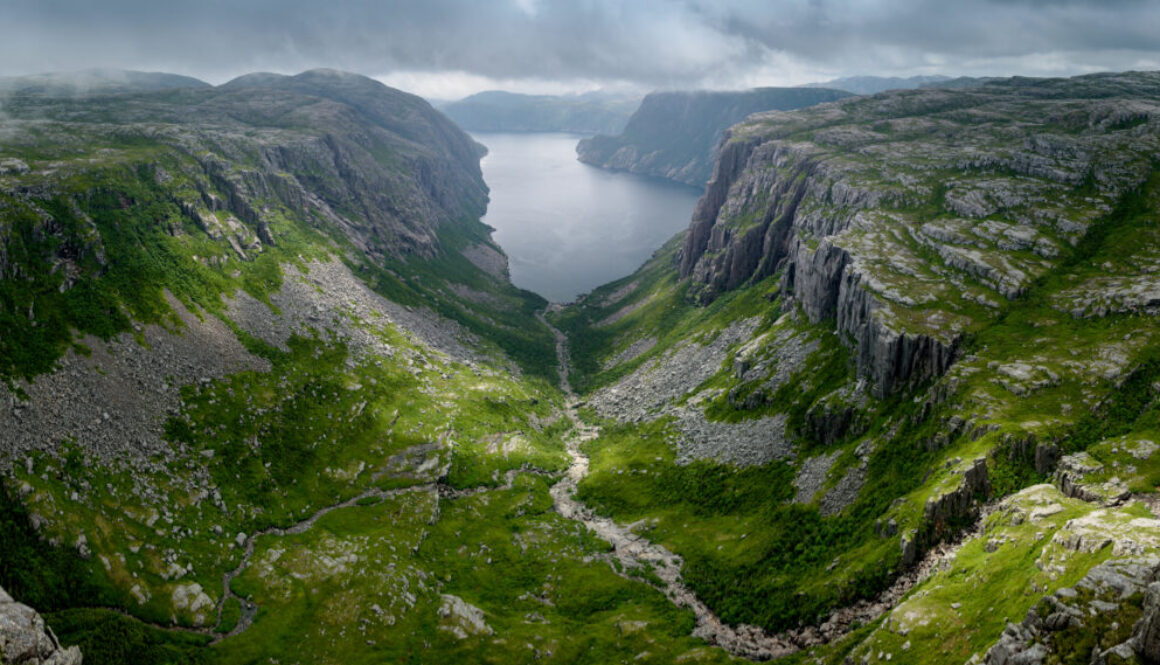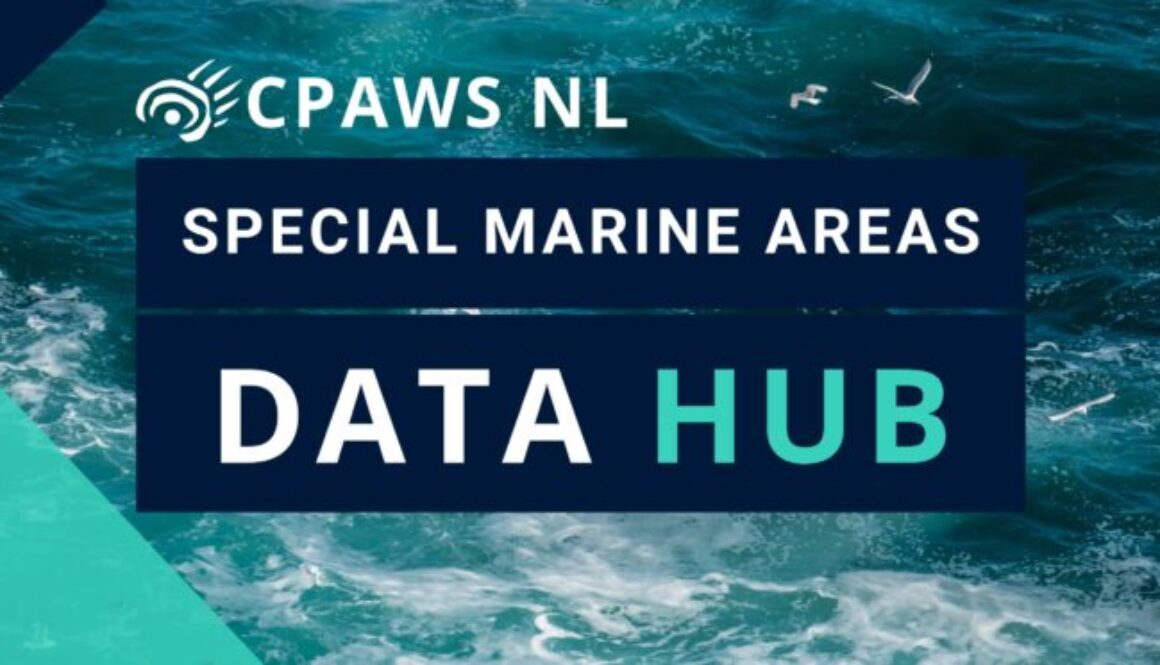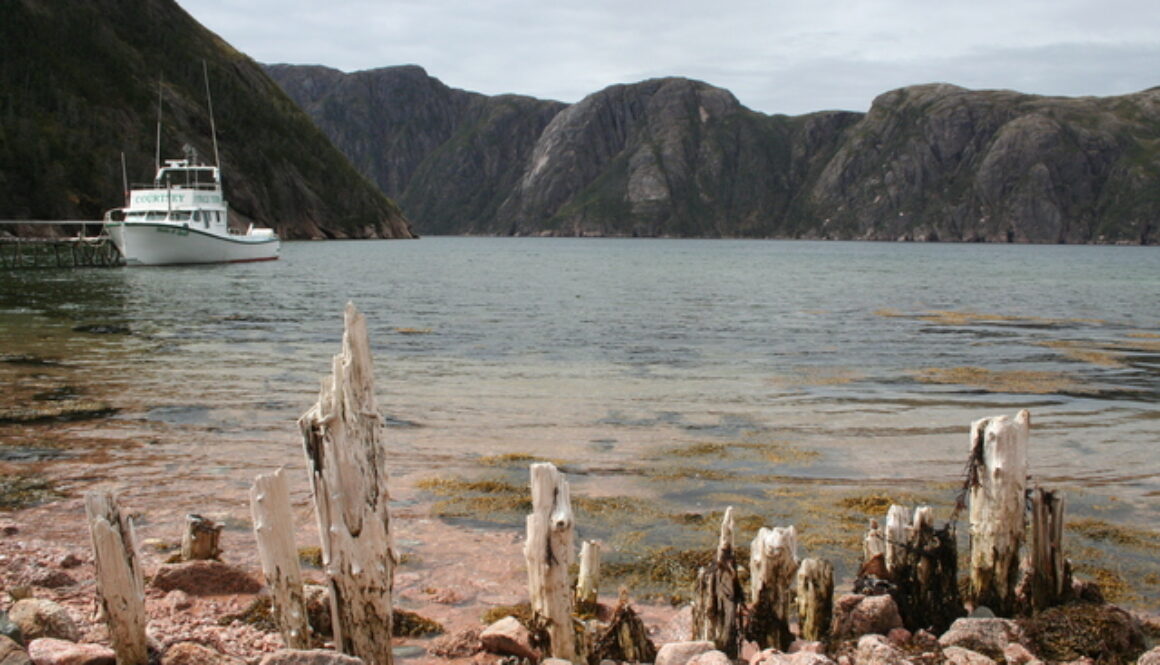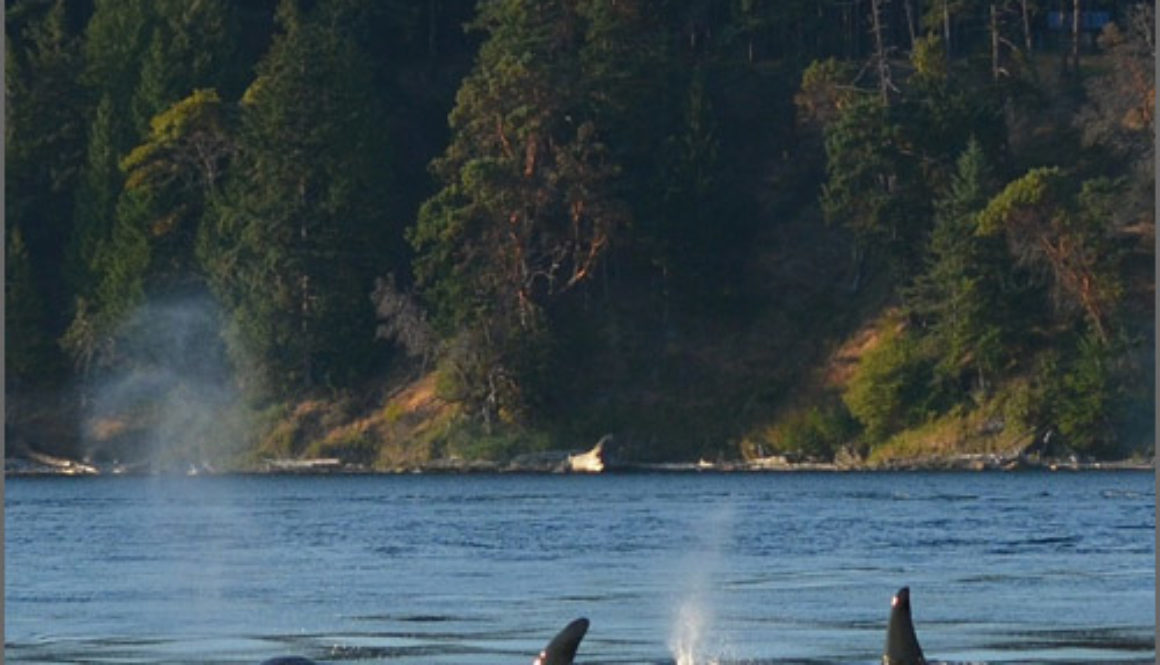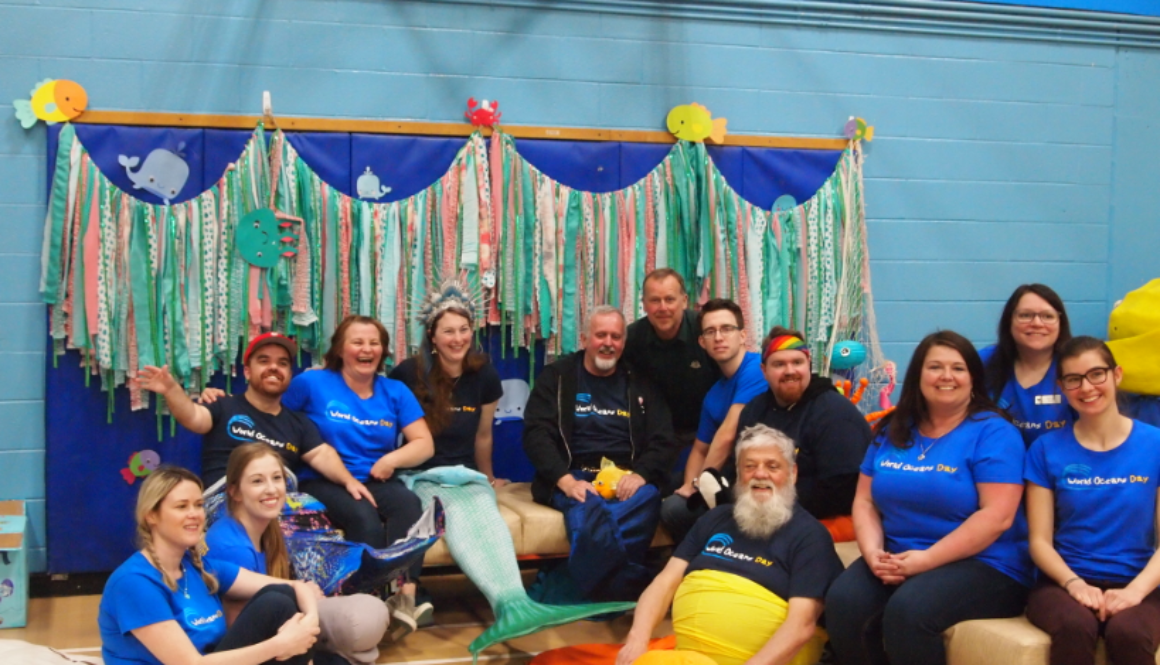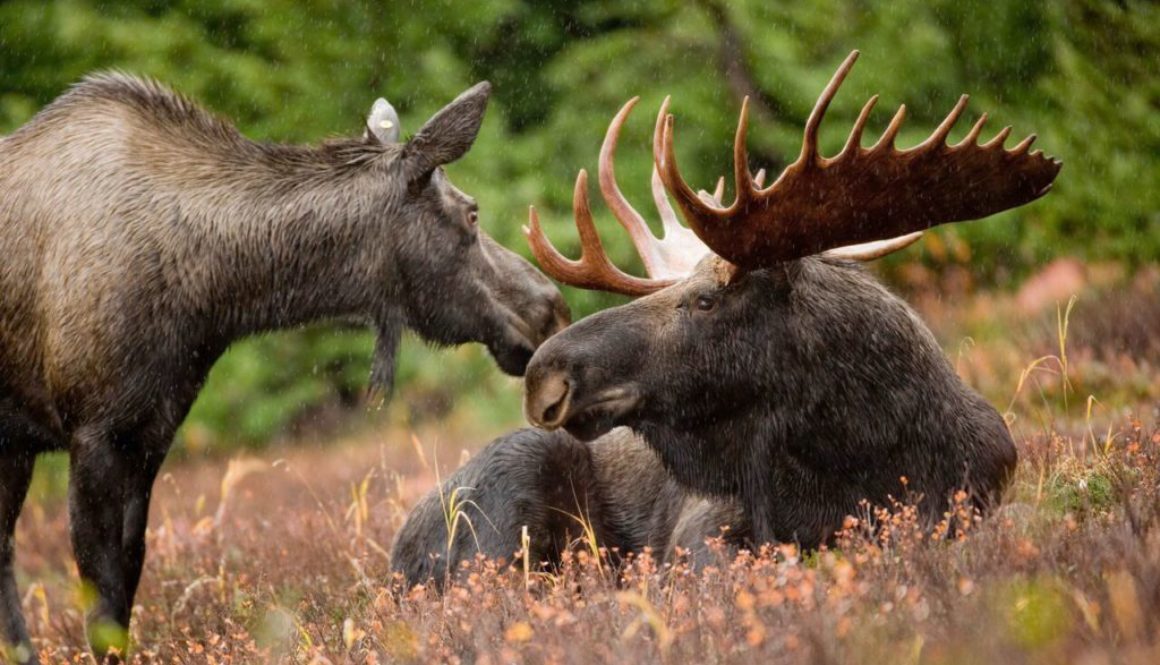Adopt-a-Beach

The Adopt-A-Beach program is an initiative led by CPAWS-NL and aimed to recruit volunteers as Stewards in key communities to monitor birds washing up on their local beaches on a bi-weekly basis.
Beached bird surveys are a valuable tool to monitor various sources of mortality occurring in the marine environment, which can otherwise be difficult to assess. They provide information on mortality occurring in the offshore marine environment, such as:
- Exposure to oil pollution
- Entanglement with fishing gear
- Weather-related stranding
Having volunteers monitor local beaches will increase public awareness and appreciation of these types of surveys, birds as an indicator species, the marine environment, oil pollution, etc. Awareness will lead to public support and ownership for local beach surveys and will result in volunteer stewards providing valuable high quality data on beached birds.
The data collected will be used to provide scientific-based information that will help with management decisions at various levels. Monitoring mortality rates is critical in ensuring our marine environment and its resources are health, sustainable and available for future generations.
Interested participants will be provided with survey kits and trained by a Wildlife Biologist from Environment Canada’s Canadian Wildlife Service.
For more information on our Adopt-a-Beach program, please read our brochure: Adopt-a-Beach Brochure.
Common Seabirds of Newfoundland
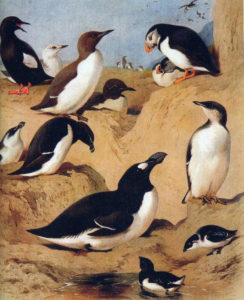
Alcids, also known as Auks, although closely resembling penguins are not related and are believed to be an example of convergent evolution. Alcids are well known for being excellent underwater swimmers – sacrificing grace in the air and on land for this ability. Alcids are pelagic birds, spending most of their adult life at sea, going ashore only for breeding. They are monogamous (only one partner for life) and philopatric (returning to the same nesting site year after year).
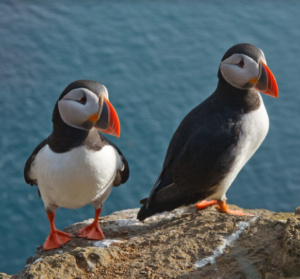 Atlantic Puffin
Atlantic Puffin
Typically standing no more than 28-30 cm tall, the Atlantic Puffin is known for their distinctively bright orange-coloured bill and feet.
Puffins are excellent swimmers, able to dive up to 60m below the surface to look for food. They are not, however, good flyers. They need to flap their wings up to 400 times per minute in order to remain airborne.
They spend the majority of their lives at sea, however in the spring puffins gather in colonies on the coast of the North Atlantic Ocean to breed. The Witless Bay Ecological Reserve, located off the coast of Witless Bay, Newfoundland is the largest puffin colony in North America and the second largest colony in the world. There is also a smaller colony located off the coast of Elliston, Newfoundland.
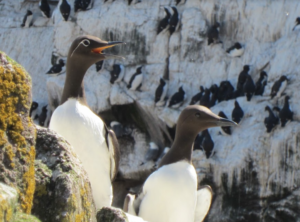
Murres
Commonly referred to as a “Turr” in Newfoundland, the Murre is larger than the small Atlantic Puffin – ranging in height from 38-46 cm. In North America there are two species of Murres: the Common Murre (or Thin-Billed Murre) and the Thick-Billed Murre.
The Murre has the most densely packed nesting colonies of any bird species. Nesting spots can be so close together that incubating adults may be touching other adults on both sides. They make no physical nest, and instead incubate their single egg on a bare rock ledge on a cliff face.
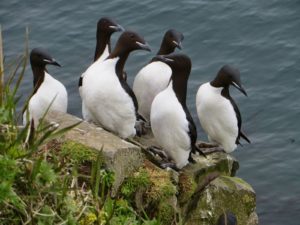
Common Murres have a thin, dark, and pointed bill, which sets them apart from the Thick-Billed Murres, whose bills are short and thick with a white gape stripe.
Some individuals, known as the Bridled Type, have a white ring around their eyes that extends back as a white line. This is a polymorphism – a different form but not a different species.
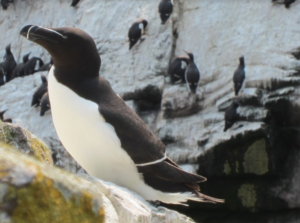 Razorbills
Razorbills
The Razorbill Auk (or lesser Auk) is the closest living relative of the extinct Great Auk. Their thick blunt bill is very distinct, as well as the white line that extends from their eye to the end of the bill.
The parents spend equal amounts of time incubating their eggs, and once the chick has hatched, they take turns foraging for their young. Like the Murres, Razorbills nest along coastal cliffs in enclosed or slightly exposed crevices.
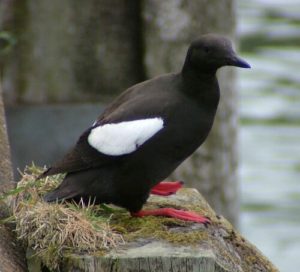 Black Guillemot
Black Guillemot
Black Guillemots can be seen in and around its breeding habitat of rocky shores, cliffs and islands in single or smalls groups of pairs. They have mostly black feathers, but in the summer they have large white patches on the tops of their wings. Their bills are black while their feet are coral-red. In the early fall, adults lose their summer plumage – their upper plumage becomes flecked with light grey and white, their head is pale grey, their bellies are white, and their legs and feet a pale red.
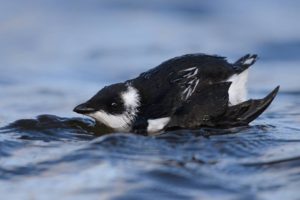 Dovekie
Dovekie
The Dovekie (also known as Little Auk) breeds on islands in the high Arctic, and come south in the winter months. They small, only about half the size of the Atlantic Puffin. These birds forage for food like other auks by swimming underwater – they tend to prefer eating crustaceans, especially copepods, but will also eat invertebrates and fish.
Adult birds are black on the head, neck, back and wings, with white underparts. Their bill is very short and stubby and they have a small rounded black tail.

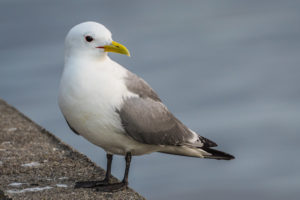
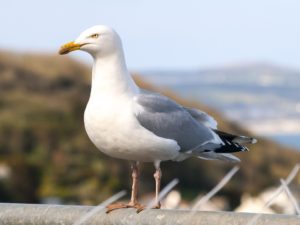 The gerring gull is a large gull that occurs in a variety of habitats including coasts, lakes, rivers and garbage dumps. They have a broad diet which includes invertebrates, fish, and many other items. They usually nest near water, laying around three eggs in a scrape on the ground.
The gerring gull is a large gull that occurs in a variety of habitats including coasts, lakes, rivers and garbage dumps. They have a broad diet which includes invertebrates, fish, and many other items. They usually nest near water, laying around three eggs in a scrape on the ground. The great black-backed gull is the largest in the gull family, with a wingspan of 1.5-1.7m. The adult great black-backed gull has a white head, neck and underparts, dark grey to black wings and back, pink legs and yellow bill.
The great black-backed gull is the largest in the gull family, with a wingspan of 1.5-1.7m. The adult great black-backed gull has a white head, neck and underparts, dark grey to black wings and back, pink legs and yellow bill. The ivory gull is a small gull which breeds in the Arctic and has a circumpolar distribution throughout Greenland, northernmost North America, and Eurasia. They are typically about 43cm high, with a pigeon-like appearance. Unlike other gulls, they have completely white plumage, lacking the grey back of other gulls. Their thick bill is blue with a yellow tip, and the legs are black. In the breeding season their bill is tipped with red, and their eyes have a fleshy, bright red eye-ring.
The ivory gull is a small gull which breeds in the Arctic and has a circumpolar distribution throughout Greenland, northernmost North America, and Eurasia. They are typically about 43cm high, with a pigeon-like appearance. Unlike other gulls, they have completely white plumage, lacking the grey back of other gulls. Their thick bill is blue with a yellow tip, and the legs are black. In the breeding season their bill is tipped with red, and their eyes have a fleshy, bright red eye-ring.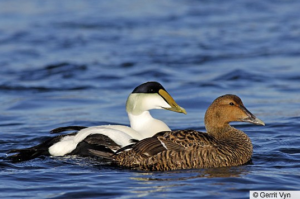 The common eider is a large sea duck that is distributed over the northern coasts of Europe, North America and eastern Siberia. It breeds in the Arctic and some northern temperate regions, but winters somewhat farther south in temperate zones, where they can form large flocks on coastal waters. They can fly at speeds up to 113 km/h. They are the largest of the eider duck, and the second largest sea duck in North America.
The common eider is a large sea duck that is distributed over the northern coasts of Europe, North America and eastern Siberia. It breeds in the Arctic and some northern temperate regions, but winters somewhat farther south in temperate zones, where they can form large flocks on coastal waters. They can fly at speeds up to 113 km/h. They are the largest of the eider duck, and the second largest sea duck in North America.
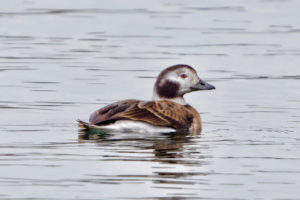
 Harlequin ducks are small sea ducks. They get their name from a Harlequin, a colourfully dressed character in Commedia dell’arte (an early form of Italian theatre).
Harlequin ducks are small sea ducks. They get their name from a Harlequin, a colourfully dressed character in Commedia dell’arte (an early form of Italian theatre).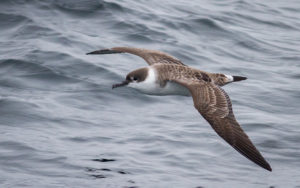 The great shearwater is a large shearwater. They nest in large colonies, laying one white egg in a small burrow or in the open grass. These nests are visited only at night to avoid predation by large gulls.
The great shearwater is a large shearwater. They nest in large colonies, laying one white egg in a small burrow or in the open grass. These nests are visited only at night to avoid predation by large gulls. The sooty shearwater is a medium to large shearwater. They are slightly smaller than the great shearwater, at 40-51 cm in length with a 94-110 cm wingspan. They also have the typical “shearing” flight of the shearwaters.
The sooty shearwater is a medium to large shearwater. They are slightly smaller than the great shearwater, at 40-51 cm in length with a 94-110 cm wingspan. They also have the typical “shearing” flight of the shearwaters.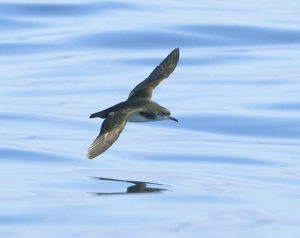 The manx shearwater is a medium sized shearwater. They are 30-38 cm in length with a 76-89 cm wingspan. They also have the typical “shearing” flight of the shearwaters. As it flies, it looks like a flying cross, as it holds its wings at right angles to the body, and it changes from black to white as the black upper parts and white under sides are alternately exposed when it travels low over the sea. The eerie, nocturnal cries of nesting shearwaters have led to associations with the supernatural.
The manx shearwater is a medium sized shearwater. They are 30-38 cm in length with a 76-89 cm wingspan. They also have the typical “shearing” flight of the shearwaters. As it flies, it looks like a flying cross, as it holds its wings at right angles to the body, and it changes from black to white as the black upper parts and white under sides are alternately exposed when it travels low over the sea. The eerie, nocturnal cries of nesting shearwaters have led to associations with the supernatural. The Leach’s storm petrel is a small seabird named after the British zoologist William Elford Leach. It breeds on inaccessible islands in the colder northern areas of the Atlantic and Pacific Oceans. It nests in colonies close to the sea in well concealed areas such as rock crevices, shallow burrows, or even logs. This storm petrel is strictly nocturnal at the breeding sites to avoid predation by gulls and skuas/jaegers, and even avoids coming to land on clear, moonlit nights.
The Leach’s storm petrel is a small seabird named after the British zoologist William Elford Leach. It breeds on inaccessible islands in the colder northern areas of the Atlantic and Pacific Oceans. It nests in colonies close to the sea in well concealed areas such as rock crevices, shallow burrows, or even logs. This storm petrel is strictly nocturnal at the breeding sites to avoid predation by gulls and skuas/jaegers, and even avoids coming to land on clear, moonlit nights. They are a small bird at 18-21 cm in length with a 43-48 cm wingspan. Like many other storm petrels, it has all-dark plumage and usually a white rump.
They are a small bird at 18-21 cm in length with a 43-48 cm wingspan. Like many other storm petrels, it has all-dark plumage and usually a white rump.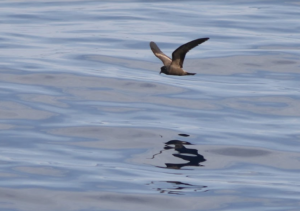 A breeding petrel stores energy-rich lipids in a sac anterior to its stomach, which is used to either sustain itself while incubating its single egg, to feed its chick, or as a defensive mechanism when caught by a predator.
A breeding petrel stores energy-rich lipids in a sac anterior to its stomach, which is used to either sustain itself while incubating its single egg, to feed its chick, or as a defensive mechanism when caught by a predator.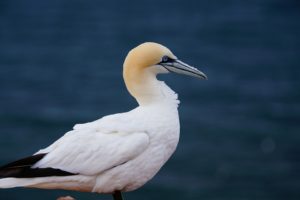 The northern gannet is the largest of the gannets. It is 87-100 cm long with a 170-180 cm wingspan. The adult has a mainly white streamlined body with a long neck, long and slender wings. The head and nape have a light golden tinge that is more prominent in breeding season, and the wings are edged with dark brown-black feathers. The long pointed bill is blue-grey, contrasting with black bare skin around the mouth and eyes. There is a black groove running along the length of their mandible that merges into the skin around the eyes. A black band of bare skin also separates the pale feathers of the forehead and throat from the bill, which gives them their distinctive face markings, and their eyes are a striking blue. Juveniles, however, are mostly grey-brown, becoming increasingly white in the five years it takes them to reach maturity. Males and females are typically similar in size and appearance, although males can be more deeply coloured than females.
The northern gannet is the largest of the gannets. It is 87-100 cm long with a 170-180 cm wingspan. The adult has a mainly white streamlined body with a long neck, long and slender wings. The head and nape have a light golden tinge that is more prominent in breeding season, and the wings are edged with dark brown-black feathers. The long pointed bill is blue-grey, contrasting with black bare skin around the mouth and eyes. There is a black groove running along the length of their mandible that merges into the skin around the eyes. A black band of bare skin also separates the pale feathers of the forehead and throat from the bill, which gives them their distinctive face markings, and their eyes are a striking blue. Juveniles, however, are mostly grey-brown, becoming increasingly white in the five years it takes them to reach maturity. Males and females are typically similar in size and appearance, although males can be more deeply coloured than females.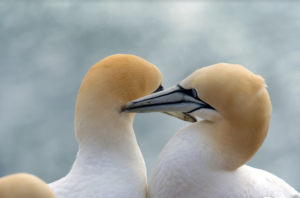
 Gannet is derived from Old English “ganot”, meaning “strong or masculine”. As a conspicuous and common bird, it has been mentioned in several ancient myths and legends.
Gannet is derived from Old English “ganot”, meaning “strong or masculine”. As a conspicuous and common bird, it has been mentioned in several ancient myths and legends.